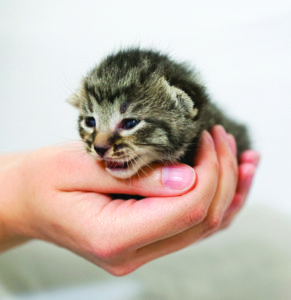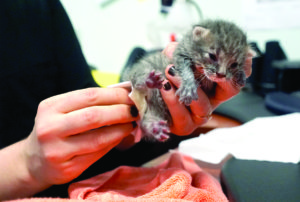
Gina was in her back yard last April when she heard faint cries. She didn’t immediately see anything out of the ordinary, but she followed the sounds to her old shed, where she was surprised to find four tiny, meowing kittens. Gina knew they must be very youngthey were smaller than any kitten she’d ever seenbut their mother was nowhere in sight. She wanted to help, but wasn’t sure how.
In the spring and early summer months, known as “kitten season,” stories like this are very common. This is the time when female cats go into heat and when most litters are born. That means an abundance of kittens! Although that sounds amazing, it’s actually a very uncertain time for all those kittens. Most people who find kittens outside hand them over to shelters. Most shelters do not have care programs for kittens who are neonatal (less than four weeks old), so instead many kittens are killed. It’s up to compassionate individuals to step up and save these kittens’ lives by keeping them out of shelters.
Taking care of neonatal kittens is a round-the-clock job for several weeks. The great news is, if mom can’t be found, humans can step in to help and anyone can learn how. Caring for kittens means you are saving lives. It’s an invaluable learning experience for you and your family, and it can be a truly fulfilling journey. Alley Cat Allies can guide you through every step, with plenty of online resources at alleycat.org/Neonatal.
Tip: Not sure how old your kittens are? Our Kitten Progression Guide can help! Visit alleycat.org/KittenProgression.
You found young kittens outside. Now what?

Do not take the kittens to a shelter, unless the shelter has a neonatal program. First, try to find their best possible caregiver: their mother. Monitor the kittens from a distance for a few hours to see if mom comes back. If she does, leave the kittens with her. If you believe they are in danger, trap her and take them all in. Visit alleycat.org/FindFeralFriends to see if there is a Feral Friend in your area who can help you trap.
If the mother doesn’t return, take the kittens inside. You can contact local cat advocacy groups to see if they can take the kittens. However, if you’re ready to care for them yourself, we have the basics you need to know.
Taking care of neonatal kittens

First, make sure the kittens are warm and hydrated. Young kittens get cold easily, which can become life-threatening. Provide kittens with a soft nest, such as fleece fabric in a box.
Tip: A cool way to keep kittens warmplace them in an open cooler with a heating pad! Make sure they have some space to move away from the heat.
Susan Spaulding, co-founder of the National Kitten Coalition (kittencoalition.org) and a celebrated neonatal kitten expert, has advice to help you keep your kittens safe and healthy.
“Kittens should feel very warm if you pick them up and their gums should be bright pink and moist,” she says. “If they are not warm, start providing warmth immediately and seek help.”
Feeding your kitten

Neonatal kittens under four weeks old must be fed around the clock. They should only be fed kitten formula, which can be purchased at most pet supply stores. Make sure to pick up kitten bottles at the store too, as they’re specially designed for kittens. For more information on the supplies you’ll need, check out alleycat.org/KittenCareKit.
How often you feed depends on the kitten’s weight. Remember to weigh every kitten at least once a day! They should gain weight daily, and weight loss is a sign of problems.
“A general rule for healthy, stable kittens who are too young to eat solid food is to weigh the kitten and divide their weight in half to know the hours you need to feed,” says Susan. “Just follow the guide on your kitten formula to see how much to feed them.”
Tip: A four-ounce kitten will need to be fed every two hours. A six-ounce kitten, every three hours. An eight-ounce kitten, every four hours.
When feeding kittens, place them on their stomachs and arch the bottle so less air gets in. Do not feed kittens on their backs, as you might a human baby, or they may inhale formula and choke. After feeding, put them on your shoulder or on their stomachs and pat them gently to burp them.
Neonatal kittens must be stimulated to go to the bathroom after every feeding. Mom does this with her tongue, but you can use toilet paper or a damp cotton ball. Gently rub the kitten’s anal area to stimulate urination and defecation after every feeding. A healthy kitten will urinate almost every time you stimulate them and have a bowel movement once or twice a day.
Balancing your life and your kittens
Caring for kittens is a round-the-clock job for a few weeks. Try to build a network of caregivers with family, friends, and neighbors. As the saying goes: it takes a village!
If your job allows you to bring your kittens in, keep them close to you in a container like a cooler, with a blanket, and provide the usual care.
“I have seen an entire office get involved in the care of these vulnerable babies, including helping with vet care costs and adoption,” says Susan.
If you can’t bring kittens to work, you can find help in your community: Stay-at-home parents may want to share the experience with their kids, someone living in a retirement community may appreciate the opportunity to help, or a friendly neighbor could assist. On top of ensuring that your kittens are safe and healthy, sharing your knowledge and your kitten care duties is a great way to bring your family or community together.
Some shelters provide resources to those who want to raise kittens. With help from Alley Cat Allies, the Hillsborough County Pet Resource Center in Florida created a Wait Until 8 Program to help empower the community. When someone brings a young kitten to the shelter, the staff offers a Kitten Survival Kit and instructions to care for the kitten.
“We thought a few people here and there would take us up on the offer, but we found ourselves having to reorder and make kits all the time because people were super responsive,” said Scott Trebatoski, the Department Director of Pet Resources. “We saw dramatic reductions in neonatal kitten euthanasia because the community really stepped up!”
The next steps of kitten care
When kittens are over four weeks old, you can start weaning them by mixing their formula with wet food.
“Most kittens can begin eating canned food around four to five weeks of age,” says Susan. “After a week or so, they will move to pure solid food. But keep offering the bottle until the kittens are completely comfortable eating and drinking.”
Litter training should start when a kitten is around three weeks old. Make sure you use a shallow litter pan so they can easily access it.
When the kittens are eight weeks old and at least two pounds, they’re ready to be spayed or neutered and vaccinated. Take them to your local veterinarian or find a low-cost spay/neuter clinic near you. After the kittens recover, you can work on finding them loving homes of their own!
Tip: Spread the word to get your kittens adopted! Talk about your kittens with your friends, family, coworkers, organizations, and clubs, or your local veterinary office.
You have the power to save lives!
Caring for kittens is a big responsibility, but it’s worth it. Remember, you have the power to bring your family and community together to help a kitten grow up healthy and strong. All it takes is commitment and care.
The basics in this article are just the start. You can find information, resources, and advice you need to become a kitten expert at alleycat.org/KittenGuide. You can also check out our kitten care webinars at alleycat.org/Webinar.

